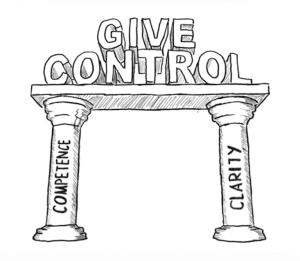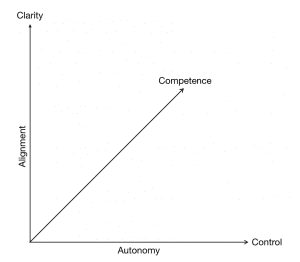This is a continuation my series comparing Strategy Deployment and other approaches, with the intent of showing that there are may ways of approaching it and highlighting the common ground.
Leader-Leader is the name David Marquet gives to a model of leadership in his book Turn the Ship Around, which tells the story of his experiences and learnings when he commanded the USS Santa Fe nuclear submarine. Like Stephen Bungay’s Art of Action with its Directed Opportunism, the book is not directly about Strategy Deployment, but it is still highly relevant.

The Leader-Leader model consists of a bridge (give control) which is supported by two pillars (competence and clarity).
This has a lot of synergy with the alignment and autonomy model, also described by Stephen Bungay, and the two could be overlaid as follows:
In other words:
- Giving control is about increasing autonomy.
- Creating clarity is about increasing alignment.
- Growing competence is about increasing the ability to benefit from clarity and control.
Update: The above graph has been revised in a new post on Leader-Leader and Autonomy-Alignment.
The overall theme, which is what really struck a chord with me, is moving from a “doing” organisation where people just do what they are told and focus on avoiding errors, to a “thinking” organisation where people think for themselves and focus on achieving success. In doing so, organisations can…
achieve top performance and enduring excellence and development of additional leaders.
That sounds like what I would call a learning organisation!
Marquet achieves this with a number of “mechanisms”, which he emphasises are…
[not] prescriptions that, if followed, will result in the same long-term systemic improvements.
Instead they are examples of actions intended to not simply empower people, or even remove things that disempower people (which both still imply a Leader-Follower structure where the Leader has power over the Follower), but to emancipate them.
With emancipation we are recognising the inherent genius, energy, and creativity in all people, and allowing those talents to emerge. We realise that we don’t have the power to give these talents to others, or “empower” them to use them, only the power to prevent them from coming out. Emancipation results when teams have been given decision-making control and have the additional characteristics of competence and clarity. You know you have an emancipated team when you no longer need to empower them. Indeed, you no longer have the ability to empower them because they are not relying on you as their source of power.
That’s what Strategy Deployment should strive for as organisational improvement that allows solutions to emerge from those closest to the problem. Or to paraphrase that definition using David Marquet’s words, achieving organisational excellence by moving decision authority to the information.


Love it!
This reminds me of the trust formula. Trust in an individual = (Competence + Reliability + Shown concern for others) / Self-promotion. The denominator need not be zero or even that close to zero if the numerator is high. Some amount of self-promotion can be useful in getting things done after all.